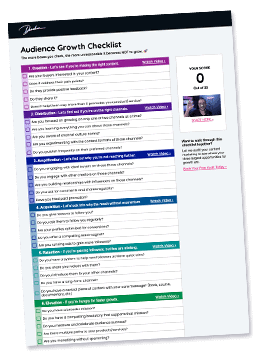At the beginning of many high-profile YouTube videos is typically a light, poppy, royalty-free intro song which serves to engage and excite the audience at the very start of the video. This article will provide you with everything you need to know on how to achieve the best soundtracks for your YouTube content.
So, how do YouTubers find their intro songs, and how do you know if you’re choosing the right song for your video? The top 5 sources of royalty-free music YouTube Audio Library, Hooksounds, Amazon, dig ccMixter and Audiojungle.
Your song choice will be based on:
- Target Audience
- Tone of Video
- Purpose of Video
There are many caveats to choosing the perfect intro song for your YouTube video and from where to source them. Some sources require payment, others are free, some require crediting of sourcing, others don’t. Given that you’ve already set the tone of your channel and purpose of the video content, you can consistently choose the proper intro music to keep your audience engaged and refreshed.
Free vs. Paid Royalty-Free Sources
Here are the top 11 best royalty-free music sources:
- YouTube Audio Library
- Hooksounds
- Amazon
- dig ccMixter
- Audiojungle – I personally just pay the subscription for Envato Elements to get unlimited access to all of the music (plus way more).
- Filmstro
- Epidemic Sound
- Soundstripe
- Bensound
- PremiumBeat
- Artlist.io – My personal favorite. It’s the best balance of quality for the price. So many great tracks for $200/year.
What is “Royalty Free”?
Before we dive in, let’s first establish what “royalty-free” means. What this means is that a content creator is free to use these audio tracks without fear of a given product (video, podcast, etc.) being flagged for copyright, or having to pay a royalty fee every time the track is played. Uses of these tracks are therefore unlimited after download and/or purchase.
Get The Audience Growth Checklist 🚀
Your content deserves an audience. Find out how to get the reach it deserves.
This does not mean that royalty-free music is not under copyright! The original composer of the track owns the copyright to the music – they’ve just made it available for public use.
It is important to remember the difference between “royalty-free” and “rights-managed.” According to PremiumBeat, tracks provided under a Rights Managed license are those which require a user to pay the royalty fee each time the song is played.
Make sure to read the site info or the description of the track before downloading or purchasing a license.
Now, although it is common courtesy to credit the source, it is not required, and, unless specified, there are no penalties for neglecting to do so.
Pricing of Royalty-Free Music
Bensound is one source that requires crediting to their site without a paid license (this option is known as the “Free Creative Commons License”). This means that a content creator can choose whichever song suits their fancy on the website at any given time, and use the track as many times as they like, as long as they credit Bensound in either the product description or within the product itself:
Example: In a video, one would say, “This music was provided by Bensound dot com.”
However, if a user purchases the “Pro License,” they are not required to credit Bensound.
There are many different Pro Licenses offered, and they differ based on use and platform:
- Standard, USD 42.49: online videos, animations, presentations, etc.
- Extended, USD 80.85: cinema, TV, radio, games, etc.
- National TV/Radio Advertising, USD 721.43: [self-explanatory]
- Subscription, USD 172.90: all Bensound tracks no matter what the use.
Audiojungle provides tracks at $1 each to start, prices at PremiumBeat range between $49 to $199, Soundstripe provides annual memberships starting at $135, etc.
The moral of the story here is that royalty-free music ranges in price based on your needs, platform and regularity of use: it can be free with conditions or cost up to several hundred dollars one time or annually.
What’s the Point of Using Royalty-Free Music?
Many content creators, especially those such as “Let’s Play-ers,” are constantly faced with the potential of an individual, corporation or other entity flagging their content for copyright violation. (By the way, anyone can flag your content for copyright, even if they do not own the song.)
The complaint against you won’t always be successful, of course, but you don’t want these flags to build up or prevent you from monetizing your content (which is one of the direct repercussions of copyright violation).
Other consequences include your content not being allowed to play on social media platforms, and even lawsuits.
One of my favorite channels, FarFromSubtle, solves the problem of potential flagging by either speaking over the music which plays over video game cutscenes or cutting the segment in the middle of the song.
However, if you don’t always want to be on high alert, can’t afford to record music yourself, or hire someone else to do so, you can turn to royalty-free music.
Although it does still incur a cost in some cases, as outlined earlier, using royalty-free music allows you to use the music you envision with your content without the risks or fees associated with other avenues.
Tips & Tricks: Choosing the Perfect Song
There are a few tricks to choosing the perfect song for your video.

First, consider the mood you’re wanting to get across in your video intro: Do you want your audience to get excited? Is video educational? Conversational? What is the target audience?
Biteable separates typical intro music into four main categories:
- Quick & Simple
- Epic
- YouTube Live (what we’ll call “Waiting Room”)
- “Sticks Around”
For all of these categories, you’ll want to keep the intro music short and sweet. Give the audience just enough to become engaged, without dragging it out too long to where they either begin to wonder if there’s going to be a full song they have to skip or lose interest entirely.
Remember: your audience came to your channel for your content, so give that to them as quickly as possible.
Second, be careful of volume! There are few deterrents as bad as intro music blaring through your headphones. A typical response to this would either be to click away from the video as quickly as possible or mute the video immediately, creating the potential of the audience missing out on important information (such as social media names included in an intro voiceover or “subscribe”/ “click here” prompts).
Lastly, consider whether or not you want the song to stick around in the background for the entirety of the video (“Sticks Around”), fill the silence (“Waiting Room”) or serve only as a quick soundbite to set the tone (Quick & Simple; Epic). The varying purposes will dictate the type of music you choose.
Upbeat pop-music or even some rock music is more suited to Quick & Simple, whereas R&B, jazz or slower pop music is better for the “Waiting Room” or “Sticks Around.”
You Don’t Have to Stick to Only One Song!
It’s important to remember that you are in no way married to only one intro song!
Some YouTube channels, such as Good Mythical Morning, have kept the same melody over the years, but make subtle changes to the track in instrumentation, tempo, etc. This keeps the content feeling fresh, yet familiar, as the channel ages and grows.
Additionally, the intro music can be changed according to holiday seasons, similarly, keeping the same general melody, or even the same key or genre, while switching the primary instrument to bells for, say, a Christmas episode, or an organ for a Halloween episode.



